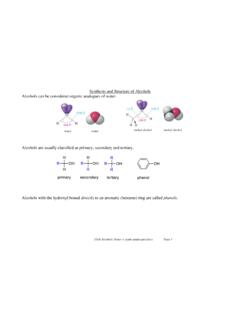Transcription of Protein Synthesis - Phoenix College
1 Protein SynthesisProtein SynthesisHow Genes Become Constituent MoleculesMendel and The Idea of GeneWhat is a Chromosome?A chromosome is a molecule of DNA True False50%50% SynthesisHow Genes Become Constituent MoleculesProtein Synthesis : What Is It? All proteins are synthesized according to instructions contained in the DNA nucleotide sequence, which is unique to every individual Protein Synthesis is a two step process that consists of transcription and Synthesis : What Is It? During transcription a molecule of messenger RNA (mRNA) is synthesized according to instructions provided by the DNA During translation, a polypeptide chain will be produced according to instructions provided by the mRNAP rotein Synthesis in Prokaryotes In prokaryotes, transcription and translation occur in the same cellular compartment the cytosol. Ribosomesare the site of translationProtein Synthesis in Eukaryotes In eukaryotes, mRNA is synthesized in the nucleus from pre-messenger RNA (pre-mRNA) molecules, and then shipped to the cytoplasm, where translation occurs RNA processing (or post-transcriptional modification) refers to the molecular mechanisms that lead to the production of mRNA from main difference between Protein Synthesis in eukaryotes and in prokaryotes is: where the process what the process the participants in the process the process participants in the processThis cartoon represents: Protein Synthesis translation in Protein Synthesis Synthesis in in Synthesis in prokaryotesProtein Synthesis .
2 From Gene to Protein Genes are stretches of nucleotides organized in triplets Different arrangements or DNA triplets encode for each one of the 20 amino acids that make proteins During transcription, a DNA triplet will produce an mRNA codon. During translation, a codonwill constitute an amino acidProtein Synthesis : From Gene to ProteinDNAmRNAP roteinTranscriptionTranslationTranscript ion: What Is It Transcribed? RNA polymerase binds to the gene s promoter region and starts making a molecule of mRNA until it finds a mark in the gene or termination sequence. The term transcription unit refers to the segment of DNA between the sites of initiation and termination of transcription by RNA polymerase. More than one gene may reside in a transcription : InitiationNascent mRNA: RNA transcriptTranscription: ElongationTranscription: Elongation RNA is synthesized according to DNA/RNA base pairing rules:A(DNA) U(RNA)G(DNA) C(RNA)T(DNA) A(RNA)C(DNA) G(RNAThe Making of an mRNADNA5 ATTGCGTAGTGGGATTAT 3 RNAT ranscription: TerminationRNA polymerase : RNA transcript : unwound DNA translation s initiation translation s elongation translation s termination33%33%33% s s s terminationRNA polymerase : promoter : transcription unit translation s initiation translation s elongation translation s termination33%33%33% s s s terminationThis cartoon illustrates: translation s initiation translation s elongation translation s termination33%33%33% s s s terminationTranscription.)
3 Eukaryotic Promoters In eukaryotes, promoters are activated by DNA binding proteins or transcription factors TATA boxes are segments of about 30 base pairs to which RNA polymerase bindsTranscription in Eukaryotes: Splicing of pre-mRNA Molecules Eukaryotic transcripts (pre-mRNA) contains exons(coding sequences) and introns(non coding sequences) Post-transcriptional modifications ( splicing) remove intronsbefore shipping the final mRNA to the cytoplasmTranscription in Eukaryotes: Splicing of pre-mRNA Molecules Spliceosomesare organelles in which the excision and splicing reactions that remove intronsfrom pre-mRNA occur Ribozymesand small nuclear RNAs(snRNA) are contained in spliceosomesTranscription in Eukaryotes: Splicing of pre-mRNA MoleculesIntronsare not translated. True False50%50% only occurs in eukaryotes. True False50%50% : Production of Polypeptide ChainsTranslation: transfer RNA (tRNA) Every transfer RNA (tRNA) has a specific sequence of nucleotides, complementary to an mRNA codon the anticodon.
4 Opposite to the anticodon, there is an attachment site specific for each of the 20 amino : transfer RNA (tRNA)Translation: mRNA/tRNAI nteraction The recognition of codon(mRNA) and anticodon(tRNA) occurs in the ribosomes. Ribosomeshave sites of tRNAanchorage and exiting A growing polypeptide will be produced following instructions in the mRNAT ranslation: Initiation and Elongation of the Polypeptide Chain A start codon(AUG) complements with the Methionine(Met) tRNAin the ribosome, constituting the translation initiation complex A new anticodonwill land in the A site, and its amino acid will join Met. The tRNAwill slide to the P site leaving the A site free for another anticodonTranslation: Initiation and Elongation of the Polypeptide ChainTranslation: Termination A stop codon(UAG, UAA, or UGA) signals the end of the mRNA molecule. A release factor triggers the disassembling of the two ribosomal units and the mRNA : codon: transcription mRNA pre- mRNA tRNA DNA25%25%25%25% : anticodon: translation mRNA pre- mRNA tRNA DNA25%25%25%25% : triplet : genetic message mRNA pre- mRNA tRNA DNA25%25%25%25% An mRNA molecule is generally translated simultaneously by several ribosomesthat constitute polyribosomesAnchorage of Proteins After TranslationGene Expressio










